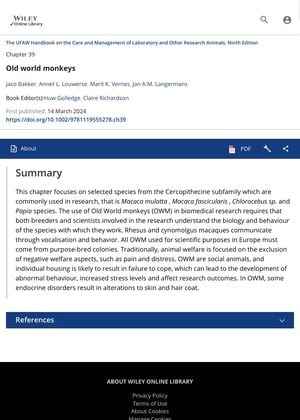TLDR Old World monkeys are important for research but require proper social housing and welfare to ensure valid results and minimize stress.
This chapter discusses the use of selected Old World monkey species, specifically Macaca mulatta, Macaca fascicularis, Chlorocebus sp., and Papio species, in biomedical research. It emphasizes the importance of understanding their biology and behavior for both breeders and scientists. The chapter highlights that all Old World monkeys used in European research must come from purpose-bred colonies and underscores the significance of animal welfare, noting that social housing is crucial to prevent abnormal behavior and stress, which can impact research outcomes. Additionally, it mentions that some endocrine disorders in these monkeys can lead to changes in their skin and hair coat.
11 citations
,
May 2019 in “Journal of Medical Primatology” Alopecia in rhesus macaques is linked to pregnancy, not stress.
21 citations
,
June 2016 in “Journal of Medical Primatology” Captive management practices affect hair loss and stress in rhesus monkeys, with differences between facilities.
23 citations
,
March 2016 in “American Journal of Primatology” In female rhesus monkeys, hair gain is linked to reduced stress levels.
 17 citations
,
November 2013 in “American Journal of Primatology”
17 citations
,
November 2013 in “American Journal of Primatology” Different monkey species in a lab showed varying levels of hair loss due to factors like type, sex, age, season, and living conditions.
87 citations
,
February 2009 in “PubMed” Alopecia in captive primates can be caused by many factors, so thorough testing is needed before blaming stress.
 51 citations
,
January 2003 in “Hormone Research in Paediatrics”
51 citations
,
January 2003 in “Hormone Research in Paediatrics” Hormones and their receptors, especially androgens, play a key role in hair growth and disorders like baldness.
 April 2003 in “Experimental Dermatology”
April 2003 in “Experimental Dermatology” The workshop highlighted the genetic links and psychological impacts of hair loss and skin disorders.
 5 citations
,
December 2005 in “Clinical Techniques in Equine Practice”
5 citations
,
December 2005 in “Clinical Techniques in Equine Practice” Skin and hair changes in horses can indicate serious diseases, and recognizing these signs is important for treatment and management.
 68 citations
,
March 1965 in “The BMJ”
68 citations
,
March 1965 in “The BMJ” Hormones and genetics affect hair growth and patterns, with some changes reversible and others not.
 98 citations
,
December 2008 in “Journal of Investigative Dermatology”
98 citations
,
December 2008 in “Journal of Investigative Dermatology” Prolactin affects hair growth and skin conditions, and could be a target for new skin disease treatments.







